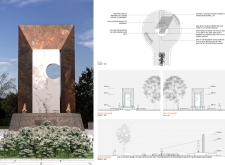5 key facts about this project
The design addresses the complex emotional journey associated with four significant life stages: normal life, life during genocide, life after genocide, and the pursuit of hope for a return to normalcy. Located in a visible area that faces east and elevated away from nearby streams, the monument acts as a space for both remembrance and contemplation. The concept interweaves spatial organization and materiality, allowing visitors to actively engage with the histories it honors.
Spatial Configuration
The design outlines clear distinctions between each life stage through thoughtfully arranged spaces. The movement from normalcy to crisis is communicated using different patterns that evoke strong feelings. Rough surfaces express the turmoil experienced during genocide. In contrast, smoother patterns emerge in the sections depicting recovery, highlighting healing and compromise. This careful spatial arrangement fosters a deeper connection with the stories being told.
Memorial Features
Key elements of the design include memorial features like a wooden bench, which offers a quiet place for reflection. This addition allows visitors to personally engage with the experiences represented in the monument, promoting moments of contemplation and remembrance. These human-sized elements play a crucial role in creating an inviting atmosphere, enhancing the site's purpose as a space for introspection.
Planting and Landscaping
The landscape surrounding the monument is adorned with various species of flowers, chosen to bring a sense of peace to the site. These plants offer not just visual relief but also symbolize growth and renewal, reinforcing themes of hope and healing amid the weight of past trauma. The incorporation of greenery works together with the architectural elements, creating a balanced relationship between nature and the built environment.
Materiality and Symbolism
The flooring features a deliberate mix of materials. Dark metal highlights the serious aspects of the genocide experience, while white marble serves as a counterpoint, signifying hopes for peace and positive change. This contrast in materials deepens the narrative within the monument, helping visitors connect with the shared stories through their visual and tactile experiences.
A fire lamp quietly stands at the center, illuminating the site during nighttime. It serves as a reminder of enduring memories and faith, casting soft reflections that enhance the contemplative nature of the surroundings.






















































